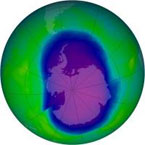Ozone Hole Shrinkage
Auckland-based National Institute of Water and Atmospheric Research (NIWA) studies have found that the ozone hole over Antarctica has shrunk to the smallest in five years, decreasing about 22 million square kilometres from 24 million square kilometres last year. “We can’t definitively say the ozone hole is improving from one new year of observations,” NIWA atmospheric scientist Stephen Wood said. “However, we have now had a few years in succession with less severe holes. That is an indication we may be beginning to see a recovery.” The ozone layer, which protects humans from carcinogenic ultraviolet radiation, was depleted by man-made compounds such as chlorofluorocarbons (CFCs). These were banned in 1987.














